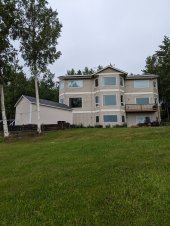You are using an out of date browser. It may not display this or other websites correctly.
You should upgrade or use an alternative browser.
You should upgrade or use an alternative browser.
SolArk15k vs Eg4 18k
- Thread starter Tiger Tom
- Start date
DIYrich
Solar Wizard
The Sol-ark consumes 90 watts on stand-by, and more when working. I would build a box out of rigid foam board insulation, and cover it in winter. That should keep it warm. Maybe air vent on bottom to keep it from getting too warm.
SolarSamAK
New Member
Hey Shadowmaker,I am surprised of this here. Not the fact that your inverter is mounted low/outside/Alaska. That has to be a major waste of energy to melt that much snow and keep the grass green all year round. I mean I live 62 degree North here in Finland and we have -35C days in the winter, but my tall concrete foundation can get frost on it as early as -3C and it's not a crawling space, I have rooms there underground (three story building). Also my house is 70 years old so no modern building materials used, thought thoroughly renovated some 15 years ago.
Don't know how much you pay for gas heating (nobody uses gas heating here), but if it's not free, I'd expect notable savings with some insulation.
At first I was going to install my inverters outside, next to my panel array, but eventually decided against it because I wanted batteries. I have some 150m from my panels to my "solar corner" (=old horse stable, now fully insulated) and another 100m to my house, so expensive ground cables were needed.
My home is pretty efficient in regards to heating. I have a 5 star energy rating and would say I pay less for heating per sqft than about 98% of the people in my city. I have a condensing boiler, tons of zones, all radiant and all digital controls plus a side arm for mixing with a super store hot water heater. Each floor has a manifold allowing for these multiple zones. All bedrooms have their own thermostat. Two attached double garages also have their own temperature control. My current home of 3800 sqft plus 4 car heated garage (garage are set to 50 degrees) is cheaper to heat than my previous home of just 1800 sqft no heated garage. My previous home was forced hot air, also gas. My boiler is rated a 97.5 efficient.
Here in Alaska we are mostly new to solar and probably not as advanced as some other states that may get more sun year round. That being said we take our heating seriously and have some pretty efficient systems. My home is well insulated, so much so I have whisper green fans in all bathrooms running 24/7 as the home is on the edge of being too tight. Plus the upward air movement helps radiate the heat. The downside to all this insulation, 24 inches of R 49 in my attic means the panels on my roof will likely be snow covered for a while. Like I said we are good at heating not so great at solar. My concrete slab does have styrofoam board insulation around it but the ground is still warmed by that radiant heat.
Think of the heated sidewalks you may see at some stores in the winter. Likely they are not heated to anywhere near my home's temperature yet the snow melts not just over the sidewalk but to a few feet around them. When the snow comes I will take a picture for you guys.
Sam
shadowmaker
Solar Addict
While your heating setup seems to be well thought, you do understand how much energy has to be wasted to keep 2 feet worth green grass through winter in harsh climate like ours? I bet I could easily heat my old horse stable (300m2/3200sqft, but only +10C/50F) and my nicely insulated outdoor swimming pool (20m2/220sqft, +30C/86F throughout the year) through the winter months with that much energy.Hey Shadowmaker,
My home is pretty efficient in regards to heating. I have a 5 star energy rating and would say I pay less for heating per sqft than about 98% of the people in my city. I have a condensing boiler, tons of zones, all radiant and all digital controls plus a side arm for mixing with a super store hot water heater. Each floor has a manifold allowing for these multiple zones. All bedrooms have their own thermostat. Two attached double garages also have their own temperature control. My current home of 3800 sqft plus 4 car heated garage (garage are set to 50 degrees) is cheaper to heat than my previous home of just 1800 sqft no heated garage. My previous home was forced hot air, also gas. My boiler is rated a 97.5 efficient.
Here in Alaska we are mostly new to solar and probably not as advanced as some other states that may get more sun year round. That being said we take our heating seriously and have some pretty efficient systems. My home is well insulated, so much so I have whisper green fans in all bathrooms running 24/7 as the home is on the edge of being too tight. Plus the upward air movement helps radiate the heat. The downside to all this insulation, 24 inches of R 49 in my attic means the panels on my roof will likely be snow covered for a while. Like I said we are good at heating not so great at solar. My concrete slab does have styrofoam board insulation around it but the ground is still warmed by that radiant heat.
Think of the heated sidewalks you may see at some stores in the winter. Likely they are not heated to anywhere near my home's temperature yet the snow melts not just over the sidewalk but to a few feet around them. When the snow comes I will take a picture for you guys.
Sam
When the winter comes I usually wait for -20C weather and lend my friend's nice IR camera to see if there are heat leaks anywhere on my buildings. Usually windows are the only noticeable leaks and I have four layer windows. Walls, concrete foundations and roofs usually match outside temperature and most certainly gravel around my buildings does the same. My energy bill is still substantial because I have over 1500m2/16000sqft heated or moderately heated buildings here.
Solar is quite new here too, or at least it is to me. To fight snow I installed my bifacials vertically and jury is still out to decide if it was a clever thing to do or not. So far it looks promising, especially in winter, but it's too early to say anything yet.
SolarSamAK
New Member
Hey Shadowmaker,
I do not intentionally heat that areas around my house just excess or a biproduct of my radiant system. I doubt it gets to the 140F temperature of the water being sent through the pex and concrete. Pure accidental conduction. I need just 32F to melt the snow or even less as I melting from the lowest layer to the ground out. Snow is an insulator here in Alaska. Having some on your roof actually helps prevent heat loss. Snow on a solar panel, well that is a bummer. My panels face south, not solar south, but magnetic south. Just learned about that. Not too far off though from solar south.
I will take a picture of my southern facing side of the house at some point. We have tons of radiant solar heat. Large windows and wood floors love soaking up all that sun. In the summer the candles on our dinning room table have melted from this radiant power. Perhaps my encouragement to getting solar.
Snow seems to improve bifacial return due to the reflection of light. Also solar production is better in colder weather and lots of sun. I base this on my friends in Alaska who have gone solar before me, a few have ground mounts with bifacials. You appear to be in Finland. May I ask if your panels are covered with snow through the winter months? Also do you use micro inverters? I ask about the micro inverters as most of my fellow Alaskans who use them, almost all use Enphase, seem to have a high failure rate. I would say on average 5 to 10% yearly failure rate after winter. We all assume it is the cold weather. They are rated to -40C but seem not to hold up in it. A nod to Enphase they do replace the inverters without much question, they do not cover the labor of getting them down which far exceeds the value of the micro inverter here in Alaska. Plus you have to wait till spring as roofs get icy and not much benefit to replacing a mostly snow covered panel. I have an asphalt roof. Many others have metal. Each has its issues.
Up loading pictures. Before anyone mentions it, yes, the tree, actually 2 trees, on my southern exposure will come down. They in front of my shed. My kids are insisting we replant them though I feel grafting or seeding from them is our best option. Darn swing, never should have put that up on those trees. The photo of the southern wall, showing the shed and windows is old. No longer have the satellite dish or Antenna as you can see from the roof top photos. The trees on the eastern wall, may come down, not sure yet if they need to. Still waiting for approval to turn on the system. My Sol Ark is on that eastern wall of the house.
Sam
I do not intentionally heat that areas around my house just excess or a biproduct of my radiant system. I doubt it gets to the 140F temperature of the water being sent through the pex and concrete. Pure accidental conduction. I need just 32F to melt the snow or even less as I melting from the lowest layer to the ground out. Snow is an insulator here in Alaska. Having some on your roof actually helps prevent heat loss. Snow on a solar panel, well that is a bummer. My panels face south, not solar south, but magnetic south. Just learned about that. Not too far off though from solar south.
I will take a picture of my southern facing side of the house at some point. We have tons of radiant solar heat. Large windows and wood floors love soaking up all that sun. In the summer the candles on our dinning room table have melted from this radiant power. Perhaps my encouragement to getting solar.
Snow seems to improve bifacial return due to the reflection of light. Also solar production is better in colder weather and lots of sun. I base this on my friends in Alaska who have gone solar before me, a few have ground mounts with bifacials. You appear to be in Finland. May I ask if your panels are covered with snow through the winter months? Also do you use micro inverters? I ask about the micro inverters as most of my fellow Alaskans who use them, almost all use Enphase, seem to have a high failure rate. I would say on average 5 to 10% yearly failure rate after winter. We all assume it is the cold weather. They are rated to -40C but seem not to hold up in it. A nod to Enphase they do replace the inverters without much question, they do not cover the labor of getting them down which far exceeds the value of the micro inverter here in Alaska. Plus you have to wait till spring as roofs get icy and not much benefit to replacing a mostly snow covered panel. I have an asphalt roof. Many others have metal. Each has its issues.
Up loading pictures. Before anyone mentions it, yes, the tree, actually 2 trees, on my southern exposure will come down. They in front of my shed. My kids are insisting we replant them though I feel grafting or seeding from them is our best option. Darn swing, never should have put that up on those trees. The photo of the southern wall, showing the shed and windows is old. No longer have the satellite dish or Antenna as you can see from the roof top photos. The trees on the eastern wall, may come down, not sure yet if they need to. Still waiting for approval to turn on the system. My Sol Ark is on that eastern wall of the house.
Sam
Attachments
shadowmaker
Solar Addict
My panels don't get snow covered. Here they are in blizzard and at that same time they produced ~8kW (I have four inverters, so 2kWx4=8kW), which is ~20% of my nominal peak (44,1kW). No micros, just two hybrid Deye 12/15Ks (which are about identical to Sol-Ark 15K) and two grid tied Bluesun 15Ks.You appear to be in Finland. May I ask if your panels are covered with snow through the winter months? Also do you use micro inverters?
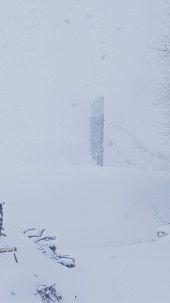
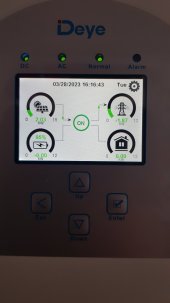
Here's one picture of the installation. Each set between two poles is 2,1kWp/1,5kWp (frontside/backside) and weights 150kg.
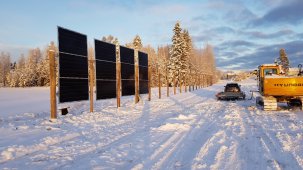
But this is getting off topic. There's a link in my signature if you want to know more about my setup.
SolarSamAK
New Member
Wow,
You are way ahead of me. That is impressive! Do you suffer much production loss in summer from the steep angle?
Your are a pro man. My install was by a professional though I may solar up my shed. POCO will not allow it to be grid tied though. Are you using super strut between posts?
Seriously you inspire me to do more.
Sam
You are way ahead of me. That is impressive! Do you suffer much production loss in summer from the steep angle?
Your are a pro man. My install was by a professional though I may solar up my shed. POCO will not allow it to be grid tied though. Are you using super strut between posts?
Seriously you inspire me to do more.
Sam
shadowmaker
Solar Addict
Certainly not a pro. Only just over half year experience on solar so far. I did go straight to the deep end with my unconventional setup and did 99% of all installations myself, but could not have finished without the help of good people here on the forum.Wow,
You are way ahead of me. That is impressive! Do you suffer much production loss in summer from the steep angle?
Your are a pro man. My install was by a professional though I may solar up my shed. POCO will not allow it to be grid tied though. Are you using super strut between posts?
Seriously you inspire me to do more.
Sam
I have only ~one month worth of winter experience so far, but best daily winter yield was 344kWh (actually many days in a row over 340kWh) and best summer yield 284kWh (usually 260-270kWh on a good day because afternoon clouds). Wrong summer angle certainly counts for something, but mainly summer production is down because of higher ambient temperatures and worse albedo. To my surprise albedo seems to have way bigger effect than I expected.
No struts anywhere. I don't want any shadows on either side of my panels. Check my build topic if you want to know how I did it.
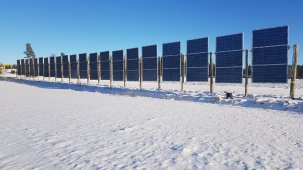
SolarSamAK
New Member
Hey Shadowmaker,
I agree the snows reflection of light and colder temps increase production more than most people account for. My few but growing number of solar friends in Alaska stress that as a big benefit having snow reflect the light . My solar shed dreams will likely involve strut for mounting as I am facing solar south and do not worry too much about shading. Plus the strut is pretty easy to use and affordable.
Do you have any fellow solar enthusiast in Finland using micro inverters? This was a hot topic on my install. I paid an installer as I have limited knowledge on solar and do not like getting up in high roofs. The debate on micro inverters is big in Alaska. Most people use them. Those who have them seem to dislike them long term as they often fail more than predicted. They also seem to way under produce. My theory is the extreme cold climate shortens their life greatly. Any insight on the topic? I am going without them so my path is set for now. Hope I made the right choice. Will send pictures of it after work today.
Sam
I agree the snows reflection of light and colder temps increase production more than most people account for. My few but growing number of solar friends in Alaska stress that as a big benefit having snow reflect the light . My solar shed dreams will likely involve strut for mounting as I am facing solar south and do not worry too much about shading. Plus the strut is pretty easy to use and affordable.
Do you have any fellow solar enthusiast in Finland using micro inverters? This was a hot topic on my install. I paid an installer as I have limited knowledge on solar and do not like getting up in high roofs. The debate on micro inverters is big in Alaska. Most people use them. Those who have them seem to dislike them long term as they often fail more than predicted. They also seem to way under produce. My theory is the extreme cold climate shortens their life greatly. Any insight on the topic? I am going without them so my path is set for now. Hope I made the right choice. Will send pictures of it after work today.
Sam
Last edited:
shadowmaker
Solar Addict
I don't think I'm the right one to say much about micros. There are lots of people here who actually uses those, so they might have more accurate info for you. To my understanding they work really well if you have mandatory shadows from trees etc. every day, or snow over your panels in winter. Also individual panels can be monitored, so it should be easy to detect problems in their early stages. That's solar porn for the real enthusiast. I decided against micros because only shadows for my array are coming from clouds and I'm pretty sure snow isn't going to be a problem for me.Hey Shadowmaker,
I agree the snows reflection of light and colder temps increase production more than most people account for. My few but growing number of solar friends in Alaska stress that as a big benefit having snow reflect the light . My solar shed dreams will likely involve strut for mounting as I am facing solar south and do not worry too much about shading. Plus the strut is pretty easy to use and affordable.
Do you have any fellow solar enthusiast in Finland using micro inverters? This was a hot topic on my install. I paid an installer as I have limited knowledge on solar and do not like getting up in high roofs. The debate on micro inverters is big in Alaska. Most people use them. Those who have them seem to dislike them long term as they often fail more than predicted. They also seem to way under produce. My theory is the extreme cold climate shortens their life greatly. Any insight on the topic? I am going without them so my path is set for now. Hope I made the right choice. My solar shed remains a work in progress but is set up currently as a mico grid to power my EV. Will send pictures of it after work today.
Sam
Shadows (snow too) have huge impact on production so try to avoid them. If you can't, use micros to get the best out of a bad situation.
So to stay with the spirit of the thread title, is anyone yet ready to make a head to head comparison of the two units?
I’m probably biased so I know which I would choose, but has the lux/eg4 yet been in enough hands to make a logical pro/con of the two?
I’m probably biased so I know which I would choose, but has the lux/eg4 yet been in enough hands to make a logical pro/con of the two?
timselectric
If I can do it, you can do it.
- Joined
- Feb 5, 2022
- Messages
- 19,853
One is a lie, and the other doesn't exist. lol
One is a lie, and the other doesn't exist. lol
Fixed version: "Hi Guys, so whats the Conclusion between Solark and EG4 18kPV?"
Sol-ark is better currently. Hopefully any lingering issues with the 18kPV can be fixed in future updates.Hi Guys, so whats the Conclusion between Solark and EG4 18k?
can both do Peak Shaving and UPS functions?
robby
Photon Vampire
- Joined
- May 1, 2021
- Messages
- 4,303
What issues have you come across with Peak shaving and the UPS functions of the Sol-Ark?Sol-ark is better currently. Hopefully any lingering issues with the 18kPV can be fixed in future updates.
I was not aware of any.
I found this one day while looking around Schneider’s web siteThey use a Low Freq., Toroidal transformer. Proven in different applications to be robust as also used in another fine brand name of inverters. The Schneider brag about many still in use 15-20 years later but only offer a 5 yr warranty. You should do some research of your own first from people who had problems and tried to contact Schneider for warranty issues before you decide. That is why I my self decided to pass on this fine unit that will do more than it is rated.
Support - Schneider Electric Solar America - Register to get 5 more Years of Warranty
on this link:
Click the drop down at right to download the below file
10-Year-Contractual-Warranty_XW-Pro6848-NA_CL60A_CL125A_USA_PuertoRico_Mariana-Islands.pdf
Zwy
Emperor Of Solar
Please expand upon this. What lingering issues with the 18Kpv?Sol-ark is better currently. Hopefully any lingering issues with the 18kPV can be fixed in future updates.
Delete.Sol-ark is better currently. Hopefully any lingering issues with the 18kPV can be fixed in future updates.
Last edited:
Rocky Broad Solar
New Member
The Sol-Ark can accept up to 17K of solar, but only 15K is usable. The EG4 can accept up to 21K of solar, but only 18K is usable.Is the sol-ark actually limited to 15kW DC solar? I thought it was 18-19kW.
In grid tied standards the Sol-Ark is a 15K and the EG4 is a 12K inverter, based on their max output current on-grid.
In off grid standards, they are both 12K inverters if the sun is not shining and they are pulling from the batteries only. If the sun is shining the Sol-Ark can get the additional 3K boost up to 15K off-grid.
If you are using them for AC coupling a large existing system that is where the Sol-Ark really out shines the EG4. Sol-Ark has up to 19,200 of AC coupling capacity while EG4 only has 12K.
I will be creating a comparison video within the next 30 days on my new YouTube channel. Check me out. Rocky Broad Solar LLC
Where did you come up with these numbers? And what is your definition of “usable?”The Sol-Ark can accept up to 17K of solar, but only 15K is usable. The EG4 can accept up to 21K of solar, but only 18K is usable.
@Rocky Broad Solar : no self promotion - that includes your YouTube channel. Please read the rules and edit your comments accordingly.
Quattrohead
Solar Wizard
I look forward to your comparison of the Solark 15K and the EG4 18K on youtube when you do it, Mr Rocky Broad Solar LLC
timselectric
If I can do it, you can do it.
- Joined
- Feb 5, 2022
- Messages
- 19,853
That would be hard to do, since one doesn’t exist. lolI look forward to your comparison of the Solark 15K and the EG4 18K on youtube when you do it, Mr Rocky Broad Solar LLC
sunflower
New Member
Military discount?! Lol!! I asked. Hubs is 100% Vietnam vet disabled. They give no military discounts! Period!Military Discount at Signature Solar?
Similar threads
- Replies
- 6
- Views
- 520
- Replies
- 0
- Views
- 275
- Replies
- 33
- Views
- 2K



